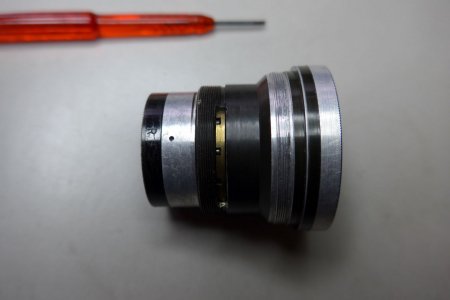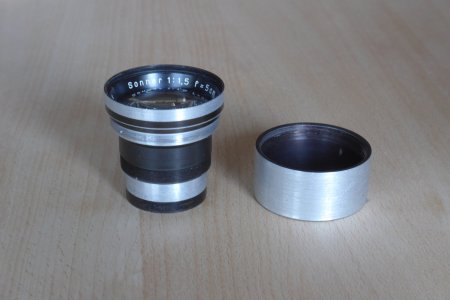I'm going to try to find a matching one and use for arm curls to build up my muscles.
The optics on this lens- breathtaking.
The optics on this lens- breathtaking.
raid
Dad Photographer
Reminds me of my WWII camera! The lens was huge. 362mm 1.9
wlewisiii
Just another hotel clerk
Oh My F'in Light. That thing is amazing. I am reminded on David Burnett's Aero-Ektar Graflex that he used at the OlympicsRare, Expensive, Big, Heavy, saved from the Scrap Heap.
Pacific Optical 12" F4. "EO" format, usually stands for Electro-Optical in my book! Could be from one of the early aerial digital cameras. My work built a 100MPixel monochrome camera 20+ years ago.
View attachment 4833941View attachment 4833942
At a different event:
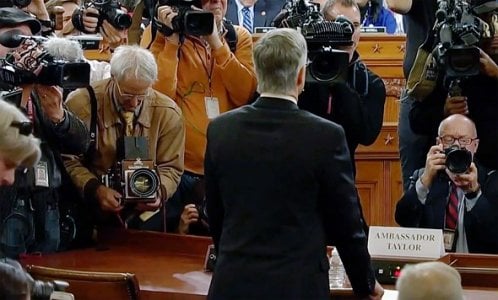
boojum
Mentor
I'm going to try to find a matching one and use for arm curls to build up my muscles.
The optics on this lens- breathtaking.
Yes, as was its application. No family vacation pics with that one.
Räuber
Established
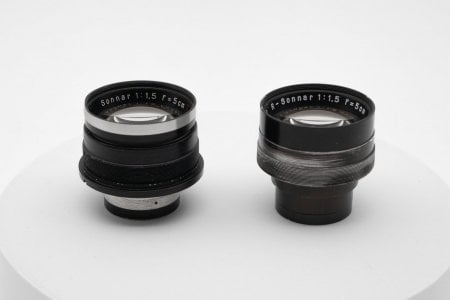
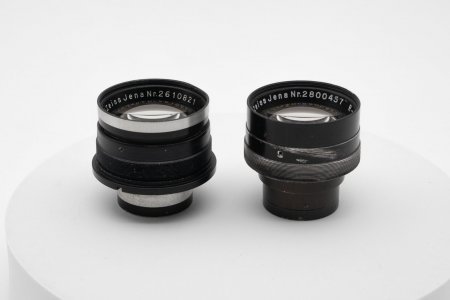
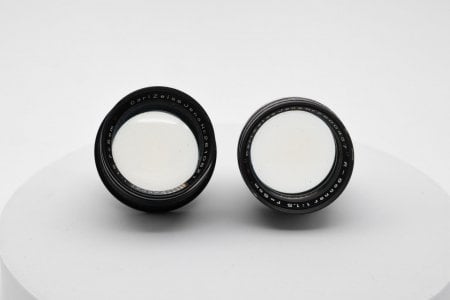
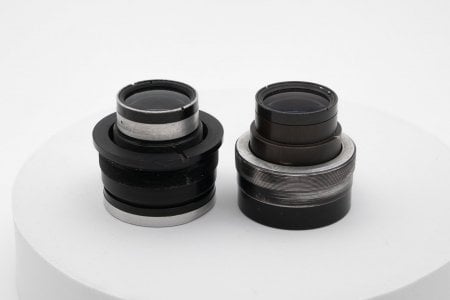
Finally I can build my X-Ray goggles! 🥳
On the left an early R-Sonnar, on the right a later R-Sonnar. Those Sonnars were used to photograph X-Ray screens. They are special in the way that they have no aperture at all. They were build for RSBK cameras. That are cameras that were used in medical sectors to take images of X-Ray images. Could not find an image of such a camera yet. But you can see the ring used by the left one to attach to the camera.
I think those Sonnars were screwed into the camera to a fix distance to the screen they should photograph. There was no way to focus it or set an aperture. It was not needed since the screen and the camera did not move and the screen was only faintly glowing. So it needed a bright sharp lens to take images of this X-Ray screen.
Interestingly the left one did not say it is an R-Sonnar at the name ring. The lens is authentic. I just noticed on the images that there is an R at the back of the lens at the rear group. I was quite surprised. Later CZJ put the R before the name at the name ring.
The right one is missing the ring to attach it to the camera but it has the M44 screw.
dexdog
Mentor
Rauber, thanks for posting this, I dont think I have ever seen an R-Sonnar in its original mount. I have R-Sonnar 2800190, but it is in a nicely-made "irregular production" LTM mount.
JakobN
JakobN
Here is another copy from the first production with the R on the rear mount but none on the name ring.
Take a look at www.lpfoto.se auction no.64 lot no.163.
Take a look at www.lpfoto.se auction no.64 lot no.163.
Attachments
Räuber
Established
Found an interesting auction that might tell the history a little further.
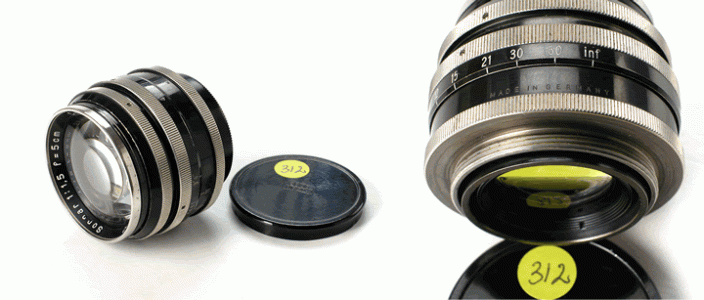
If you look closely it matches your lens. Serial 1.502.652. So just a little later. It is an inverted version of the prototype you have. It is black with white letters. The scale is in feet 3,5 - 60 - inf and it also has the MADE IN GERMANY inscription. Very nice example. Unfortunately it was sold in 2002 and the auction site only took 2 images of this unique lens and put them online. The aperture and focus scale is not visible. What a shame! I suspect that they match your lens.
The auction text mentions that it was delivered to India in the past. So who was so important (or rich) in 1934 India that he can force a protectionist firm like CZJ to manufacture one of the most precious lenses of this time in M39 mount for the concurrent Leica I ?! This had to be a gift to someone.
wes loder
Photographer/Historian
These were used on the Tenax II dark boxes for filming x-rays of lungs to spot tuberculosis. The Tenax II had their original mounts, rangefinders and shutters removed and a huge film advance was added. As many as a 1000 were made, but I have only seen a couple with their original R-Sonnars. Numbers seen: 2317778 and 2677243.
Räuber
Established
These were used on the Tenax II dark boxes for filming x-rays of lungs to spot tuberculosis. The Tenax II had their original mounts, rangefinders and shutters removed and a huge film advance was added. As many as a 1000 were made, but I have only seen a couple with their original R-Sonnars. Numbers seen: 2317778 and 2677243.
Thank you for the interesting insight to the R-Sonnar. I have seen those Tenax cameras and Sonnars in the past but I was wondering if those are the RSBK cameras mentioned in some CZJ brochures. A little correction it is 2.517.778. The 3 and 5 can easily be confused. I have to update my documentation now.
S.H.
Picture taker
Had for years this ltm biogon... I finally bought a if/iiif for it. Seems to fit OK. Now shipping off the iiif for a service and new curtains, it sat for decades in a display case. At least the summicron is not scratched.
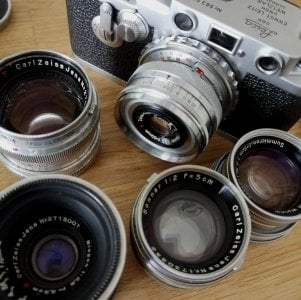
I have a nice lineup of lenses to go with it. I also have a biometar and an orthometar but the rear of the lens interferes with the rf cam at short distance. I wonder about selling these and buying a less fiddly wide angle.

I have a nice lineup of lenses to go with it. I also have a biometar and an orthometar but the rear of the lens interferes with the rf cam at short distance. I wonder about selling these and buying a less fiddly wide angle.
Buying lenses is easy, working on them is fun- selling them is a lot of work...
I've learned that the odd 5cm F1.5 Sonnars without a mount or aperture ring were used in "A Scientific Experiment" involving "Voltage Controlled Transmitters" sometime in 1970.
My lens- with hacked aperture ring and mount, made from odds and ends, and cutting a later Contax mount down.
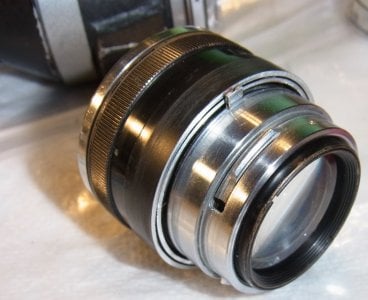
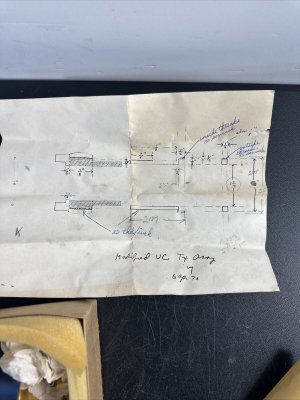
A mystery- why would someone in 1970 use uncoated camera lenses from the 1930s on an optical bench? The three lenses that I currently have in hand are all from this same lot. The rear surface of each has an unusual bloom, very heavy. Not etched, not scratched, probably induced by the experiment- probably heat. I suspect the wavelength of the light source was not in the visible range, and someone had the bright idea of using uncoated optics. This is a known problem- optical coatings used in the visible range being poor performers for wavelengths outside their design specifications. To the point that I've given a 1000mm F11 mirror lens to replace expensive optics used in some experiments- the modern coatings killed the performance. Another time, loaned my Canon 50mm F0.95 for use on a "Sensors Unlimited" Infrared sensor that cost $25K.
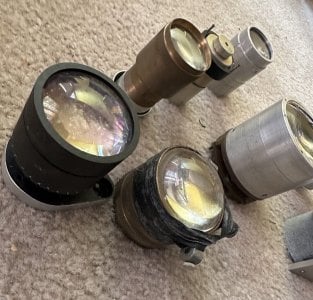
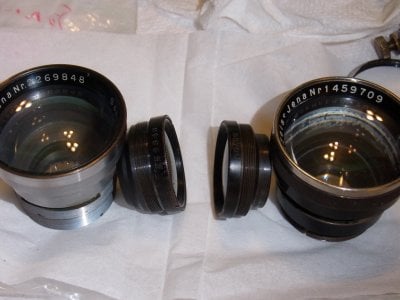
The two Mystery Sonnars as bought, no mount, no aperture linkage, no aperture ring. Both suitable for photographic use now.
What else were they used for???
Pinky to Lip, "LASERS".
I've learned that the odd 5cm F1.5 Sonnars without a mount or aperture ring were used in "A Scientific Experiment" involving "Voltage Controlled Transmitters" sometime in 1970.
My lens- with hacked aperture ring and mount, made from odds and ends, and cutting a later Contax mount down.


A mystery- why would someone in 1970 use uncoated camera lenses from the 1930s on an optical bench? The three lenses that I currently have in hand are all from this same lot. The rear surface of each has an unusual bloom, very heavy. Not etched, not scratched, probably induced by the experiment- probably heat. I suspect the wavelength of the light source was not in the visible range, and someone had the bright idea of using uncoated optics. This is a known problem- optical coatings used in the visible range being poor performers for wavelengths outside their design specifications. To the point that I've given a 1000mm F11 mirror lens to replace expensive optics used in some experiments- the modern coatings killed the performance. Another time, loaned my Canon 50mm F0.95 for use on a "Sensors Unlimited" Infrared sensor that cost $25K.


The two Mystery Sonnars as bought, no mount, no aperture linkage, no aperture ring. Both suitable for photographic use now.
What else were they used for???
Pinky to Lip, "LASERS".
Last edited:
boojum
Mentor
Buying lenses is easy, working on them is fun- selling them is a lot of work...
I've learned that the odd 5cm F1.5 Sonnars without a mount or aperture ring were used in "A Scientific Experiment" involving "Voltage Controlled Transmitters" sometime in 1970.
My lens- with hacked aperture ring and mount, made from odds and ends, and cutting a later Contax mount down.
View attachment 4836755View attachment 4836756
A mystery- why would someone in 1970 use uncoated camera lenses from the 1930s on an optical bench? The three lenses that I currently have in hand are all from this same lot. The rear surface of each has an unusual bloom, very heavy. Not etched, not scratched, probably induced by the experiment- probably heat. I suspect the wavelength of the light source was not in the visible range, and someone had the bright idea of using uncoated optics. This is a known problem- optical coatings used in the visible range being poor performers for wavelengths outside their design specifications. To the point that I've given a 1000mm F11 mirror lens to replace expensive optics used in some experiments- the modern coatings killed the performance. Another time, loaned my Canon 50mm F0.95 for use on a "Sensors Unlimited" Infrared sensor that cost $25K.
View attachment 4836757View attachment 4836758
The two Mystery Sonnars as bought, no mount, no aperture linkage, no aperture ring. Both suitable for photographic use now.
What else were they used for???
Pinky to Lip, "LASERS".
You bring to mind the old adage, "Never trust a programmer with a screwdriver." LOL
I wrote code that had display messages "LASER at 100% POWER".
boojum
Mentor
I wrote code that had display messages "LASER at 100% POWER".
ROTFLMAO I bet you did. Scare the hell out of the tyros.
It was a cool piece of code- implemented an optical feedback loop using a voltage controlled variable optical attenuator and optical amplifier. And LASERs, of course. The code was very, very fast. The fiber optic version of whatever cool experiment these lenses were used for.
rfaspen
[insert pithy phrase here]
In high school I was in the "smart kids" chem and physics classes (back when those kinds of things were well funded). My friends and I convinced our teacher, who was as nerdy as we were, to build a laser as an after-school project.
Well, we did it. A fantastic experience in engineering and applied science. One of my friends had a parent who worked at a defense contractor (shall remain anonymous to protect the [mostly] innocent) that was able to supply the most difficult to aquire part of our apparatus. The unit was a CO2 based laser, powered by an old neon light or tube amp transformer, and other details I need not go into. The resulting laser wavelength was in the UV range (don't remember the specific wavelength).
Turns out it was a rather competent unit........... while none of us got in any trouble.........we underestimated the energy output we were dealing with.
A 3/4-inch dia. hole through the wall of our class lab was enough to put an end to our project. Not the teacher's suggestion but rather from the assistant principal. Our teacher was "all in" for further fun. A cinder block was a fine backstop....we learned quickly 😉. Remember UV light is not visible.... probably not a good quality for a class project.
Thanks guys for prompting this warm memory of my childhood.
Well, we did it. A fantastic experience in engineering and applied science. One of my friends had a parent who worked at a defense contractor (shall remain anonymous to protect the [mostly] innocent) that was able to supply the most difficult to aquire part of our apparatus. The unit was a CO2 based laser, powered by an old neon light or tube amp transformer, and other details I need not go into. The resulting laser wavelength was in the UV range (don't remember the specific wavelength).
Turns out it was a rather competent unit........... while none of us got in any trouble.........we underestimated the energy output we were dealing with.
A 3/4-inch dia. hole through the wall of our class lab was enough to put an end to our project. Not the teacher's suggestion but rather from the assistant principal. Our teacher was "all in" for further fun. A cinder block was a fine backstop....we learned quickly 😉. Remember UV light is not visible.... probably not a good quality for a class project.
Thanks guys for prompting this warm memory of my childhood.
Glenn2
Well-known
Ah the good ole days. I had experiences of similar nature, also without lasting harm.
I’m fairly certain your laser would have been in the infrared range. Not even sure high power UV stuff exists yet. The oxygen in air absorbs shorter wavelengths of UV and limits power transmission that would have military use. All the CO2 lasers I’ve read about are IR.
Ah the mischief to be had in chemistry labs of yesteryear. Does nitrogen triiodide ring any bells or pop any memories?
I’m fairly certain your laser would have been in the infrared range. Not even sure high power UV stuff exists yet. The oxygen in air absorbs shorter wavelengths of UV and limits power transmission that would have military use. All the CO2 lasers I’ve read about are IR.
Ah the mischief to be had in chemistry labs of yesteryear. Does nitrogen triiodide ring any bells or pop any memories?
I made a list of chemicals that my fellow classmates were using to make explosives and gave it to the teacher for him to lock up. They were storing the stuff in a cabinet at school, and it went off on a weekend. No one hurt, but fair bit of damage.
wlewisiii
Just another hotel clerk
Thermite is a very interesting and very easy to mix in the back room of a junior high chemistry lab. A half-baked form of napalm too. Very difficult to keep those fires under control but we didn't manage to burn anything down.
Oh, did I say we? I know nothing. Nothing! 😈
Oh, did I say we? I know nothing. Nothing! 😈
Share:
-
This site uses cookies to help personalise content, tailor your experience and to keep you logged in if you register.
By continuing to use this site, you are consenting to our use of cookies.


